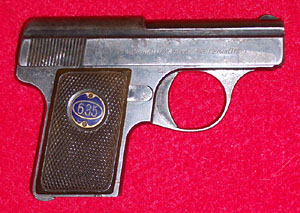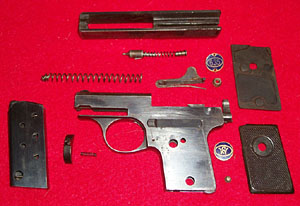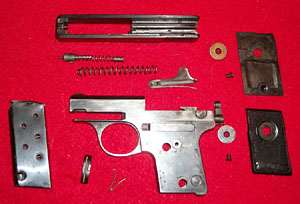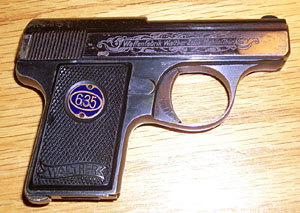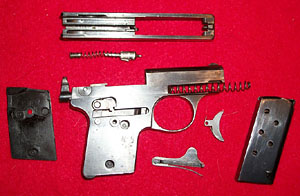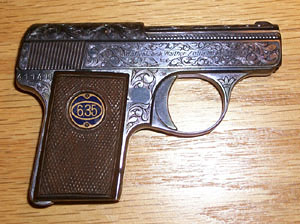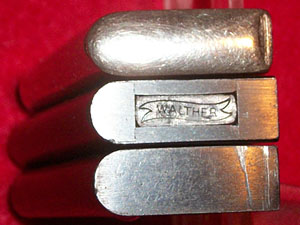 |
|||||||||||||||||||||||||||||||||||||||||||||||||||||||||||||||||||||||||||||||||||||||||||||||||||||||||||||||||||||||||||||||||
|
Walther Model 9 Variations by Earl Mount
Model 9 Walther Types are based upon significant design changes that were made to the pistol at two points during the 20+ years of production. Around 1924 and again in 1934 (or possibly 1935 ) the designers at Walther made significant alterations to the fabrication and mechanical function of the pistol. These changes establish three distinct Types of the Model 9. Also during the production life of the Model 9 there were a number of smaller changes which improved the pistol slightly from a manufacturing or aesthetic standpoint but did so without significant internal design changes. These smaller variations are noted but individually do not constitute distinctly separate Types. Total Model 9 production is estimated at around 250,000. Model 9 production volume was greatest in the early 1920s when the pistol was first introduced. During the first four years of production, from 1921 through around 1924, approximately 127,000 Type I Model 9’s were made. Then Walther made some significant changes to the pistol resulting in the Type II. Annual production volume fell off significantly and for the next 10 years, until around 1934, total production of Type II Model 9’s was approximately 108,000. In 1934 or 1935 Walther again changed the design significantly, resulting in the Type III. Model 9 production appears to have picked up slightly in 1938, before World War II broke out in September 1939. During the rest of the war years of 1940 through 1945 Model 9 production was very limited. Total production of Type III Model 9’s from 1934 until the Walther factory was shut down in May of 1945 is approximately 15,000, the majority of which were made prior to 1940.
Detailed Description of the Three Types Type I Serial Number range: 410000 (1921) to 537xxx (1924). Characteristics of the original design which describe Type I pistols and which changed over time:
Note that the complete transition from Type I to Type II took place over a range of several thousand pieces, and aspects of both Type I and Type II can be found in this serial number range. Minor Changes made during Type I production:
Type II Serial Number range: approximately 537xxx (1924) to SN 640xxx (1934). Major Changes from Type I:
Minor Changes during Type II production:
During the Type II production period Walther offered an upgrade to the standard Model 9 pistol that was designated the Model 9b. The 9b had an upgraded finish that reverted to the more decorative Type I style enamel grip retention disks, and in most cases the slide had acid etched engraving. The enamel retention disks are usually blue, but some are white. These handsome pistols were sold for a modest up-charge. Other than the grip retention disks the Model 9b was mechanically the same as the Model 9 Type II. The Model 9b should not be confused with special order Model 9’s which had high grade engraving and/or special plating and/or custom grips which are discussed below. Type III Serial Number range: approximately 641xxx to approximately 652xxx (1938) and then 190000N through 198xxxN (1940?). Major Changes from Type II:
Minor Changes during Type III production:
There are examples of some very late production Model 9’s in which parts from all eras of production are assembled into complete pistols. These pistols appear to show that the Walther factory was using up all existing parts at the end of Model 9 production. It is not known exactly when Walther produced the last Model 9. It may have been as early as 1940, or possibly as late as 1945. Exact Model 9 production numbers and dates are no longer available. However, based upon the study of surviving examples it is possible to establish reasonable estimates of production quantities and dates.
Throughout the entire production run Standard Model 9’s were available in either a high polish blue finish or with nickel plating. On a special order basis Walther offered high grade guns with custom finish options. In addition to the blue and nickel finish, gold and silver plating were offered. Walther’s famous high quality engraving service was also available. In addition, grips made of wood, ivory, or mother of pearl were options. Mechanically these beautiful Model 9’s were the same as the standard production type being made at the same time. High grade Model 9’s are seen in all types and variations. Model 9 pistols with Import Markings The Walther Firm was very active in marketing its fine products throughout the world in the period between WWI and WWII. On occasion Model 9 pistols will be found with various import markings required by different countries or added by retail outlets. These markings are found on all three Types of Model 9. Examples of these marks are tiny “MADE IN GERMANY” stamps indicating guns which were exported to the U.S.A., “VP over N” stamps with a serial number and a date stamped on pistols imported into Austria, a Rearing Lion with a serial number and a date stamped upon pistols imported into Czechoslovakia, and names and addresses of stores from San Francisco to Nairobi etched into the slide. Examples of exported Model 9 pistols are seen from the earliest 1921 production all the way until 1940. These markings add an interesting bit of personality to the guns that have them. The vast majority of Model 9 pistols seen in America do not have any import marks which implies that they were probably brought home from Europe by returning G.I.s who picked them up while serving during WWII.
As with the Model 9 pistol, the magazines for these tiny guns evolved over time. The following outlines the various details of these magazines. Walther Model 9 magazines have a six round capacity. They measure about 57mm long. Each magazine has 5 viewing holes in each side.
As with the Model 9 pistol, magazines are found in a variety of finishes. Blued, nickel, gold, gold wash. In most cases, but not all, the finish on the magazine matches the finish on the pistol. There are instances where blued magazines were issued with nickel guns, and nickel magazines were issued with blued guns. There are three variations of the base on Walther Model 9 magazines. The three variations are: Plain, flat bottom; plain, rounded bottom; and Walther logo marked bottom. The earliest Model 9s have plain, unmarked flat bottoms. These early plain, flat bottom magazines are typically observed with Type I Model 9s from the beginning serial number of 410000 up through around 436XXX. Plain, flat bottom magazines do show up occasionally in later production pistols with high grade and/or engraved finishes. Flat bottom magazines are found in all finishes. There is a short span of Type I pistols from Serial Number 438XXX through around 446XXX where Model 9 magazines with a plain, unmarked, and slightly rounded bottom are seen. All of these odd magazines are nickel finish. They are found with blued pistols as well as nickel finished pistols. These magazines cease to be seen with any later production pistols. The third and by far the most common Model 9 magazine bottom is stamped with the WALTHER banner logo. These magazines begin to show up on Type I pistols around serial number 438XXX and are seen throughout the balance Type I, Type II and Type III Model 9 production. WALTHER logo marked magazines are seen in all types of finish. There are also three variations of follower used in Model 9 magazines. The three types of Model 9 magazine follower are: Swaged, rounded followers which appear identical to followers used with the Model 8. Flat stamped followers with an exposed front that does not cover the front of the magazine spring. The third type of follower is stamped with a front that bends over the front of the magazine spring. Swaged followers are seen on magazines with flat bottoms and with WALTHER logo bottoms. Swaged followers are more common in earlier pistols. The second type of follower that is flat, stamped steel and does not cover the magazine spring is the most common and is seen on magazines with all three types of bottom. All of the rounded bottom nickel finish magazines observed have this second type of follower. This type of follower is far less common on very late production pistols. The third type of follower that is flat, stamped steel with the front that covers the magazine spring is generally seen on magazines issued with late production Model 9 pistols. This type of follower is seen with almost all Type III Model 9 pistols. Revised 1/11/2012 |
|||||||||||||||||||||||||||||||||||||||||||||||||||||||||||||||||||||||||||||||||||||||||||||||||||||||||||||||||||||||||||||||||
|
Copyright 2011 by Earl Mount. All rights reserved. |
|||||||||||||||||||||||||||||||||||||||||||||||||||||||||||||||||||||||||||||||||||||||||||||||||||||||||||||||||||||||||||||||||
|
|
|||||||||||||||||||||||||||||||||||||||||||||||||||||||||||||||||||||||||||||||||||||||||||||||||||||||||||||||||||||||||||||||||
